Tokyo Food Safety Information Center » Good things to know » A chat about mushrooms » Mushroom food poisoning
Mushroom food poisoning
1. Overview of mushroom food poisoning
(1) The state of mushroom food poisoning
Between 2004 and 2008, 42 to 79 mushroom food poisoning incidents occurred nationwide annually, involving 77 to 232 victims each year.
(2) Mushrooms which cause food poisoning
Looking at mushroom food poisoning by species, Lampteromyces japonicus makes up 29% of cases, Entoloma rhodopolium 14%, and Amanita pantherina 6%. Together, these three species make up approximately 50% of all cases of mushroom food poisoning.
In addition, in 2004 and 2007, there were reports in which Pleurocybella porrigens, once considered edible, was suspected of having caused cases of acute encephalopathy.
(3) Mushroom food poisoning period
As mushrooms largely breed in autumn, the number of people who collect and eat wild mushrooms also increases during this time. Incidents of mushroom food poisoning mostly occur in September and October, with approximately 90% of cases being concentrated in this period.
(4) Locations where mushroom food poisoning occurs
Some 90% of mushroom food poisoning cases occur in private homes. Other locations include commercial facilities such as stores and restaurants.
2. False beliefs about how to differentiate mushrooms
When you find a mushroom, you may become interested to know whether it is edible or poisonous. However, there are a large number of superstitions and false beliefs about how to tell whether a mushroom is edible. Holding such beliefs can result in eating poisonous mushrooms and experiencing food poisoning.
(1) Mushrooms with stalks which can be split vertically are edible – FALSE
The stalks of most mushrooms can be split vertically, and the same applies to virtually all poisonous mushrooms.
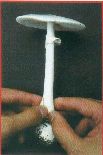 |
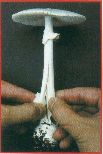 |
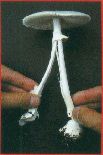 |
| The stalk of the poisonous Amanita virosa can also be easily split vertically. | ||
(2) Plain colored mushrooms are edible – FALSE
Almost all poisonous mushrooms are plain in color. In particular, Entoloma rhodopolium, Lampteromyces japonicus, and Tricholoma ustale, which cause most of the cases of mushroom food poisoning in Japan, are plain in color and look tasty. Some brilliantly colored mushrooms like Amanita hemibapha are in fact edible as well. The edibility of a mushroom cannot be determined by its color.
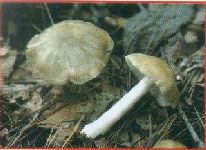 |
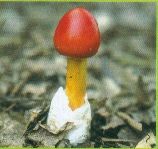 |
| Entoloma rhodopolium (poisonous) This mushroom is plain in color and yet poisonous. |
Amanita hemibapha (edible) This mushroom is brilliant in color and yet edible. |
(3) Mushrooms which are eaten by insects are edible – FALSE
Poisonous mushrooms may also be eaten by insects.
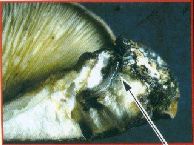 |
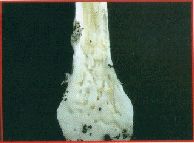 |
| An insect on a Lampteromyces japonicus (poisonous) | Marks from insect bites on a Amanita virosa (poisonous) |
(4) Any mushroom can be made edible by cooking it with eggplant – FALSE
There have been numerous cases of food poisoning caused by mushrooms cooked together with eggplant.
(5) Any mushroom can be made edible by drying it – FALSE
Drying does not destroy mushroom poisons.
(6) Pickling any mushroom in salt or washing it with water will make it edible – FALSE
Such measures have no effect on virtually all poisonous mushrooms.
(7) Mushrooms which look spongy under the cap (Boletaceae mushrooms) are edible – FALSE
It was once believed that all Boletaceae mushrooms were not poisonous, but we now know that some, such as Neoboletus venenatus, are poisonous.
A wide variety of other superstitions exist concerning how to tell if a mushroom is edible, but none are correct.
3. Methods for preventing food poisoning from poisonous mushrooms
Be sure to follow the following points in order to prevent mushroom food poisoning.
| Five articles for preventing food poisoning from poisonous mushrooms |
|
If you feel ill after eating wild mushrooms, immediately seek diagnosis at a medical institution.
If you have any of the mushroom you ate remaining, bring that with you for the medical institution to examine.
4. The primary poisons and symptoms of poisonous mushrooms.
| Mushroom species | Poisonous substances | Primary symptoms Time until symptoms appear |
Edible mushrooms similar in appearance |
|---|---|---|---|
| Tricholoma ustale | Ustalic acid | Vomiting, diarrhea (30 min. – 3 hrs.) |
Pholiota lubrica, Tricholoma ustale, Lentinula edodes (shiitake) |
| Entoloma rhodopolium | Choline, muscarine, muscaridine, hemolytic protein | Vomiting, diarrhea (10 min. – several hrs.) | Entoloma sarcopum, Lyophyllum mushrooms such as Lyophyllum decastes |
| Psilocybe mushrooms |
Psilocybin, psilocin | Dizziness, hallucinations, agitation, numbness (30 min. – 1 hr.) |
Armillaria mellea |
| Amanita verna (Amanita virosa) |
Amatoxins, phallotoxins | Vomiting, diarrhea, kidney and liver damage, death (6 – 24 hrs.) |
Tricholoma radicans, Agaricus campestris, Agaricus bisporus |
| Lampteromyces japonicus | Illudin S (lampterol) | Vomiting, diarrhea (30 min. – 1 hr.) |
Panellus serotinus, Lentinula edodes (shiitake), Pleurotus ostreatus |
| Amanita pantherina | Ibotenic acid , muscarines, muscimol | Vomiting, diarrhea, convulsions, dizziness (30 min.) |
|
| Clitocybe acromelalga | Acromelins, clitidine | Intense pain in the tips of the hands and feet lasting over 1 month (6 hrs. – 1 week) |
Clitocybe gibba, Armillaria mellea |
| Neoboletus venenatus | Bolevenines | Vomiting, diarrhea (2 hrs.) |
Boletus reticulatus |
| Hypholoma fasciculare | Fasciculic acid | Vomiting, diarrhea, convulsions, death (3 hrs.) |
Hypholoma sublateritium, Pholiota microspore, Armillaria mellea |
| Russula subnigricans | Cycloprop-2-ene carboxylic acid | Vomiting, diarrhea, whole body muscle pain, difficulty breathing (30 min. – several hrs.) |
Russula nigricans |
| Scleroderma aurantiun | Unknown | Vomiting, stomach pain, diarrhea (30 min. – several hrs.) |
|
| Amanita muscaria | Ibotenic acid, muscarine, muscimol | Vomiting, diarrhea, convulsions, hallucinations (30 min.) |
Amanita hemibapha |